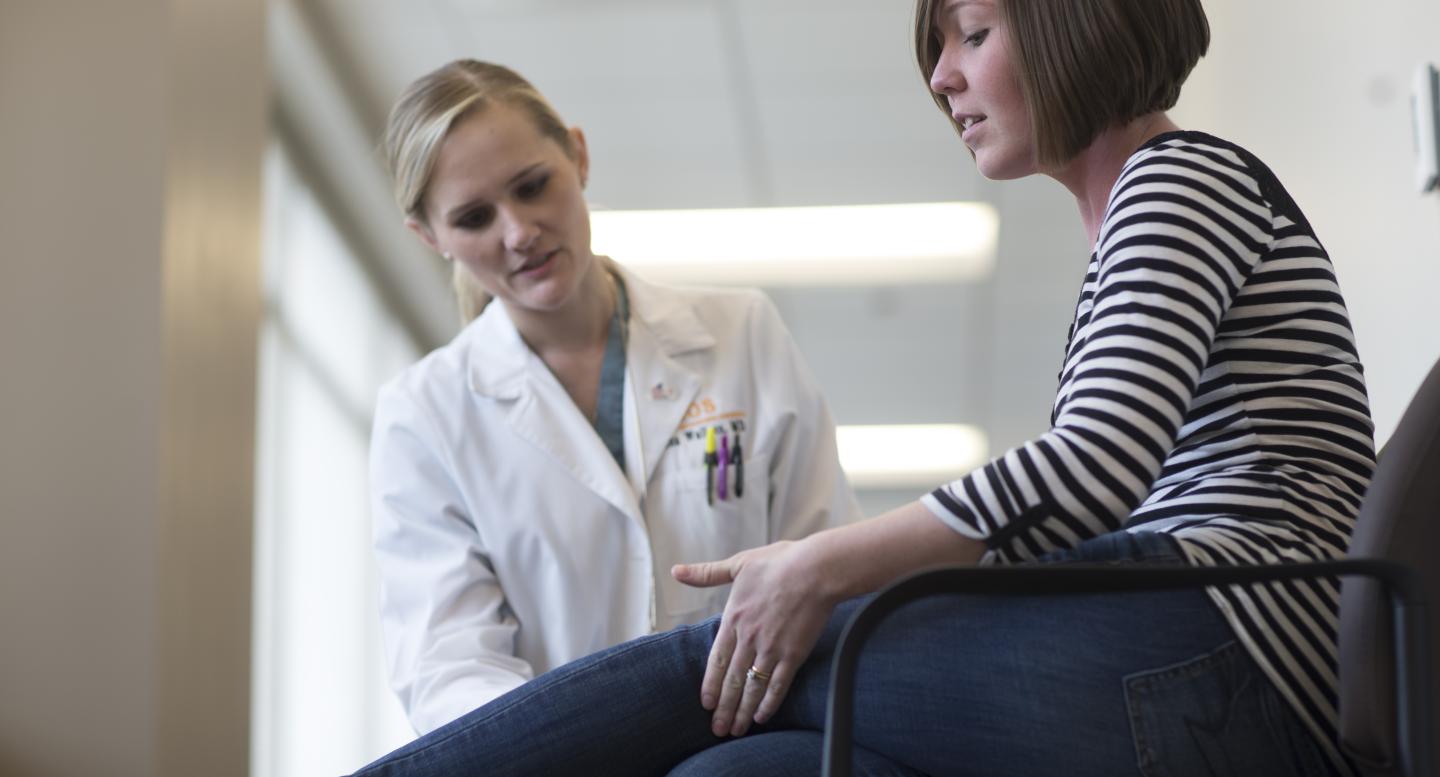How Is Bone Cancer Treated?
If you have been diagnosed with bone cancer, one of your first questions will be how to treat it. Depending on what type and stage of cancer you have, you may need more than one treatment.
It is important to talk about your cancer, including all of your treatment options, goals, and possible side effects, with your doctor. Your doctor will help you make the decision that best fits your needs.
Questions for Your Doctor
It is also very important to ask questions if there is anything you are confused or unsure about. Your questions might include:
- What type of bone cancer do I have?
- Has my bone cancer spread anywhere else in my body?
- What stage is the cancer and what does that mean?
- What are my treatment options?
- What do you recommend and why?
- Are there any risks or side effects to the treatments you suggest?
- What are the chances the cancer will come back with these treatment plans?
- What should I do to prepare for treatment?
- Based on what you’ve learned about my cancer, how long do you think I’ll survive?
In addition to these questions, be sure to write down some of your own. For instance, you might want to learn about recovery times, so you’ll know how to plan your schedule. Or you might want to learn about second opinions or participating in clinical trials.
For more information or to schedule an appointment at the Orthopaedic Oncology Clinic, please call 865-546-2663.
Bone Cancer Risk Factors & Prevention
Certain risk factors increase your chance of getting cancer. Bone cancer risk factors include things like behaviors and genes. Most risk factors don’t directly cause a disease like bone cancer, but they can often influence whether you get it and how it develops. Having risk factors doesn’t guarantee you’ll get bone cancer. People with several risk factors may never have it, while people with no known risk factors sometimes do.
Talk With Your Doctor
Know your risk factors and talk with your doctor about them. This can help you make better lifestyle and health care choices.
These risk factors may raise a person’s risk of developing bone cancer:
- Genetics
A very small number of bone cancers seem to be inherited, or passed down from your parents. They are caused by mutations (or flaws) in certain genes.
- Retinoblastoma – Children with a rare type of eye cancer called retinoblastoma may be more likely to develop soft tissue sarcomas. If radiation is used to treat the eye cancer, the risk of osteosarcoma in the bones around the eye being treated is even higher.
- Li-Fraumeni Syndrome – Li-Fraumeni (lee-FRAH-meh-nee) syndrome raises people’s risk of getting several types of cancer, such as breast cancer, brain cancer, osteosarcoma and other sarcomas.
- Rothmund-Thomson Syndrome – Rothmund-Thomson syndrome is a syndrome in children that causes short stature, skeletal problems and rashes. These children are more likely to develop osteosarcoma.
Other Conditions
- Paget’s Disease of the Bone – Paget’s disease of the bone may increase your chances of getting osteosarcoma. Other benign (not cancerous) bone diseases, like fibrous dysplasia, can also increase the risk of getting osteosarcoma.
- Multiple Enchondromatosis – Multiple enchondromatosis causes benign cartilage tumors known as enchondromas. People with this disease are at increased risk for developing chondrosarcoma.
Previous Treatments
- Prior radiation therapy – If you’ve had radiation treatments for cancer and other diseases, you are at a higher risk for developing bone cancer at the radiation site.
- Chemotherapy – Chemotherapy for another cancer can increase the chances of getting secondary bone cancer.
Prevention
Currently there is no way to prevent bone cancer. Early detection is the best hope for successfully treating the disease. If you or your child have any of these known risk factors, visit the doctor regularly. Talk with him or her about the risk factors for bone cancer.
Types of Bone Cancer
Cancers that come from the musculoskeletal system are called sarcomas. If the cancer starts in the muscles or bones, it is a primary bone tumor. Examples of primary bone cancer include osteosarcoma, Ewing’s sarcoma, chondrosarcoma, fibrosarcoma, and soft tissue sarcoma.
If the cancer started somewhere else in the body and traveled (metastasized) to the bones or soft tissues, it is called a metastatic tumor.
Primary bone tumors are rare. Secondary bone tumors are more common, and they commonly come from cancer in the lungs, prostate, breast or kidney.
Certain lesions and tumors are not cancerous, and those are called benign lesions. Even though they’re not cancerous, they need special expertise and management from your doctor. Examples include lipomas, giant cell tumors, peripheral nerve sheath tumors, and myxomas.
Malignant Tumors
Malignant, or cancerous types of bone tumors come in two types, primary and secondary. Primary tumors start in the bone, itself, while secondary tumors start somewhere else and spread (or metastasize). Primary tumors usually happen in children, though some adults get them, too.
Primary Bone Cancer
Osteosarcoma
Osteosarcoma is a very rare bone disease that occurs mainly in children and young adults. There are typically less than 20,000 cases in the United States per year. This disease requires a medical diagnosis and is treatable by a medical professional. Imaging or lab tests are always required.
Osteoscarcoma occurs most often in the long bones of the arms and legs, though it can happen in any bone. Symptoms include localized bone pain and swelling. Treatment typically involves surgery, chemotherapy and radiation.
Ewing’s Sarcoma
Ewing’s sarcoma is a cancer that typically occurs in and around the bones. It is extremely care, with fewer than 1,000 cases reported each year. It typically occurs in young adults and children, and it often begins in the arms, legs or pelvis. This disease requires a medical diagnosis and is treatable by a medical professional. Imaging or lab tests are always required.
It can cause pain in the back, joints or bones; swelling and tenderness and limping, and in rare occasions it can cause bone fractures. Depending on what stage the cancer is in, it is treated with surgery, chemotherapy and/or radiation.
Fibrosarcoma
Fibrosarcoma is a rare primary tumor, meaning that it starts in the bone, itself, rather than somewhere else in the body. About one case is diagnosed every year for every two million people. It is usually found in men aged 30 to 40. This disease requires a medical diagnosis and is treatable by a medical professional. Imaging or lab tests are always required.
Pain and swelling at the tumor site are the most common symptoms. This disease requires a medical diagnosis and is treatable by a medical professional. Imaging or lab tests are always required. Surgery is the primary treatment, though chemotherapy and radiation may also play a role.
Chondrosarcoma
Chondrosarcoma is a rare type of cancer that develops in the bones and soft tissues of the body. It occurs mainly in adults between the ages of 20 and 60, primarily men. It accounts for about 20 percent of all bone tumors and approximately 600 patients are diagnosed each year. This disease requires a medical diagnosis and is treatable by a medical professional. Imaging or lab tests are always required.
The disease usually starts in the pelvis, or in the long bones of the arms or legs, but it can be found in any body part that contains cartilage. People with this type of tumor typically do not feel sick at first, though they will eventually have pain, swelling or limited movement. The main treatment option is surgery.
Soft Tissue Sarcoma
Soft tissue sarcoma is a type of cancer that can develop in soft tissues like fat, muscle, nerves. About 12,000 new cases are diagnosed each year, with slightly more in men than women. There are more than 50 types of soft tissue sarcoma, not all of which are cancerous. This disease requires a medical diagnosis and is treatable by a medical professional. Imaging or lab tests are always required.
More than half of sarcomas begin in an arm or a leg. The first symptom is usually a lump, which isn’t often painful but can be. Treatment includes surgery, radiation, chemotherapy and other types of targeted therapy.
Secondary Bone Cancer
If the cancer started somewhere else in the body and then spread to the bone or soft tissues, it is called a secondary or metastatic tumor. The team at Orthopaedic Oncology commonly treat secondary bone cancer that has spread from:
- Breast
- Lung
- Prostate
- Kidney (renal)
Treatment depends on the type of cancer and where it has spread.
Who Will Be on My Cancer Team?
You may have several doctors on your team, which could include:
- An orthopaedic surgeon who uses surgery to treat problems of the joints and bones
- An orthopaedic oncologist who specializes in treating your type of cancer
- A radiation oncologist who is an expert in using radiation to treat cancer
- A medical oncologist who uses chemotherapy and other medicines to treat cancer
Many other specialists may be involved in caring for you, too. You’ll probably work with nurses and nurse practitioners, psychologists and social workers, rehabilitation specialists and other health care providers.
The team works with interventional and radiation oncologists. They meet several times a month at the medical center’s tumor board to discuss patient cases and to develop optimal treatment modalities.
In addition, the medical center’s Orthopaedic Oncology Clinic is the only bone cancer treatment center in Knoxville, Tennessee. That makes it easier for you to stay closer to home for your treatment.
What Are the Treatments for Bone Cancer?
There are four main treatments for bone cancer, including surgery, radiation therapy, chemotherapy and targeted therapies.
Surgery
Surgery is the main treatment for most types of bone cancer. It may also be used to take a biopsy of the cancer. The biopsy and surgical treatment are performed in two separate operations. Ideally, the same doctor should perform both the biopsy and the main surgery.
The goal of the surgery is to remove all the cancer. If even a few cells are left, they can grow to make a new tumor. To try to be sure that they get all the cancer, your doctor will remove the tumor plus some tissue around it, which is called a wide excision. After surgery, a pathologist will look at the tissue under the microscope to see if the outer edges (or margins) have cancer cells. If they do, they’re called positive. That means some cancer was left behind. If they don’t, they are said to be negative, clear or clean. A wide excision with clean margins minimizes the risk that the cancer will grow back where it started.
Arm or Leg Tumors
Tumors in the legs or arms are treated either by removing the whole limb (amputation) or by removing the tumor and leaving the limb. Most of the time, the surgeon can remove the tumor without removing the limb.
After surgery, you will need rehabilitation. This can be the hardest part of the treatment, and if possible, you should meet with a rehabilitation specialist before surgery to understand what will be involved.
Amputation – In amputation, the surgeon removes all or part of a limb, including some healthy tissue above it, to get rid of the tumor. In the past, this was how doctors treated all tumors in the arms or legs, but now they choose this only when there is a reason not to do limb-salvaging surgery.
The surgeon leaves a cuff of muscle and skin around the bone, which fits into the end of a prosthesis, or artificial limb. With proper physical therapy, patients are often walking again 3-6 months after leg amputation.
Limb-Salvaging Surgery – The goal of this surgery is to get rid of all the cancer and still leave a working arm or leg. More than 90 percent of patients with bone cancer are able to have their limb spared. This type of surgery requires a doctor with special training and expertise. They must remove the tumor while saving the nerves, vessels and tendons around it. But if cancer has grown into these structures, they will need to be removed, too. This sometimes means that the limb is painful or can no longer be used, making amputation a better option. Patients who receive limb-salvaging surgery may need more surgery within five years and some may eventually need an amputation.
Rehabilitation is more intense after limb-salvaging surgery than amputation. It takes, on average, a year for patients to learn to walk again after having a leg tumor removed. If the patient does not do rehab, the limb may become useless.
Tumors in Other Areas
When a patient has bone cancer of the pelvis, the surgeon uses a wide excision and bone grafts when possible. For jaw cancer, the entire lower half of the jaw can be removed and later replaced with bones from other body parts. For tumors of the skull or spine, a wide excision may not be possible, requiring doctors to do a combination of treatments like curettage, cryosurgery or bone cement.
Curettage (kur-u-TAHZH) – In this procedure, the surgeon scoops the tumor from the bone without removing any bone. This leaves a hole in the bone. In some cases, the surgeon will treat nearby bone tissue to kill any remaining cancer cells. This can be done with cryosurgery or by using bone cement.
Cryosurgery – During cryosurgery (sometimes called cryotherapy), the doctor pours liquid nitrogen into the hole left behind after the tumor is removed. Liquid nitrogen is extremely cold, and it kills tumor cells by freezing them. After surgery, the hole can be filled by bone grafts or bone cement.
Bone cement – Bone cement starts out as a liquid and becomes a solid. The doctor will put it in the hole in the bone in liquid form, and as it hardens, it gives off heat. The heat helps kill any remaining tumor cells, allowing this to be used without cryosurgery for some tumor types.
Chemotherapy
Chemotherapy (sometimes called chemo) uses drugs to treat cancer. The drugs enter the bloodstream and circulate to destroy cancer cells in the body. This is often part of treatment for Ewing sarcoma and osteosarcoma, but is usually isn’t used for other bone cancers because it doesn’t work as well.
Radiation
Radiation therapy uses focused X-rays to kill cancer cells. Radiation does not easily kill most types of bone cancer, so higher doses are needed. The higher doses can damage healthy nerves and tissues near the cancer. This is why it is not used as a major treatment for most types of bone tumors. (Although radiation has been successfully used to treat a type of bone cancer called Ewing’s sarcoma.)
Radiation can be used to treat bone cancer that can’t be completely removed by surgery. It may also be used after surgery if cancer cells were present in the margins, or the edges of the tissue removed during surgery. Radiation can also be used to help control symptoms like swelling and pain.
Learn more about the Radiation Oncology options available at the medical center.
Recovery and Follow-Up
A rehabilitation process will be designed to help regain function.
After surgery and treatment, frequent follow-ups with your Orthopaedic Oncologist are recommended. Two-thirds of all cancer recurrences will be detected during the first two years following diagnosis and independence. Physical therapy and exercise is vital to recovery.


